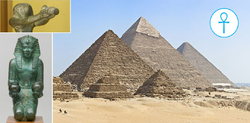- Retour accueil
- Vous êtes ici : Blog The Pyramids of the Cold The Pyramids of the Cold Section 12 • The Hauling Beetle of the Grand Gallery
The Pyramids of the Cold Section 12 • The Hauling Beetle of the Grand Gallery
Publié par Bruno Coursol dans The Pyramids of the Cold le 12/04/2022 à 20:08
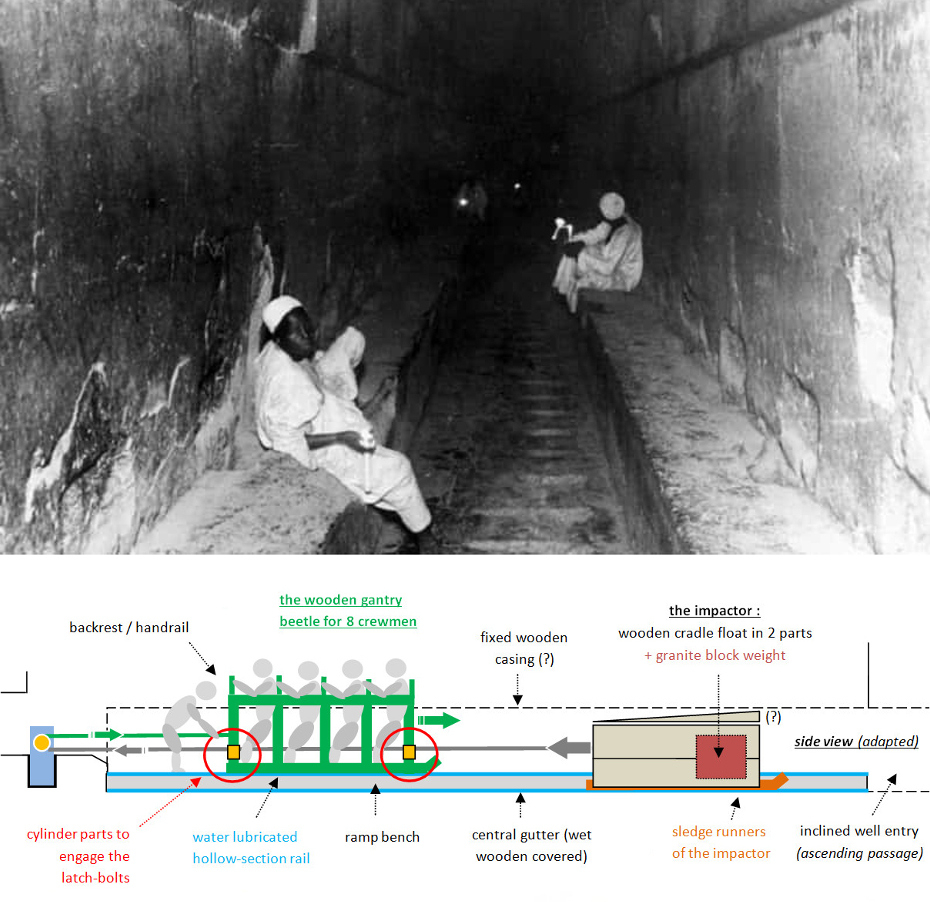
The Pyramids of the Cold - Section 12 • The Hauling Beetle of the Grand Gallery
In summary : the wooden gantry that endlessly operated the impactor of the Great Pyramid of Giza, was actually made of the assembly of 2 separate units, one on each ramp of the Grand Gallery. This structure, the "beetle", was operated by 2 teams of 4 men that were inside the gantries, while 2 other men, one on each ramp, were operating the latch bolts by forcing them inside the niches in the gallery's walls so that the beetle could be lifted back up the Grand Gallery at the end of every operating cycle.
• Hathor as a cow is a metaphoric representation of the hauling beetle
• The Apis Bull is a representation of the impactor
• Sokar is a metaphoric representation of the latch bolts
• The hauling beetle is made of 2 separate units with 4 crewmembers per unit
• 2 crewmembers are also needed to operate the latch bolts (one per unit)
• The flail is a representation of the impactor splashing water like cars do
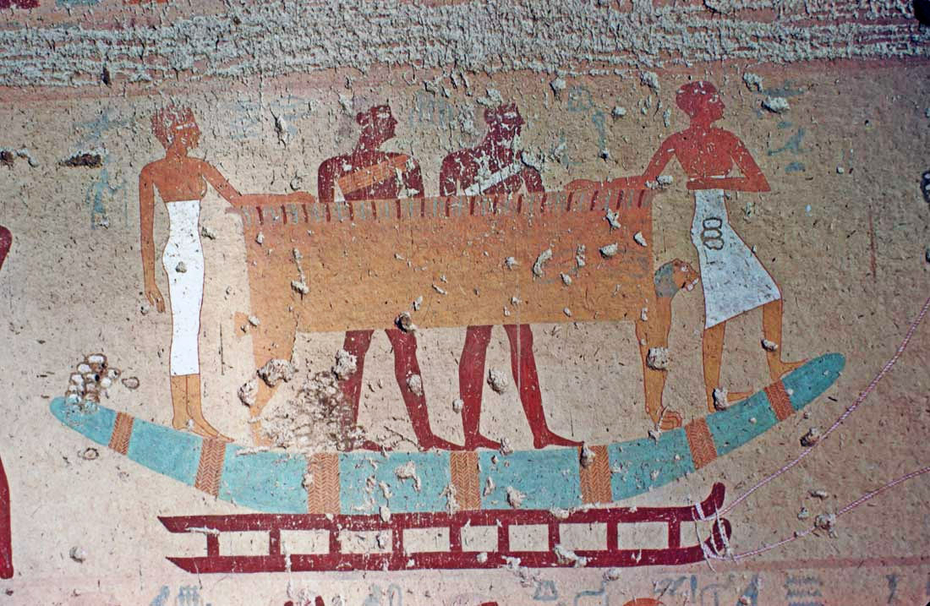
Wall relief detail of the Theban Tomb TT60, located in Sheikh Abd el-Qurna, part of the Theban Necropolis, on the west bank of the Nile, opposite to Luxor. TT60 is the burial place of a woman called Senet. She was related to the ancient Egyptian Vizier Intefiqer (mother or wife). It is one of the earliest burials in the area. Intefiqer was Governor of the city (i.e. Thebes) and Vizier of Senusret I in the 12th Dynasty. Source : https://en.wikipedia.org/wiki/TT60
Image source : osiris.net, chapter 3 "Osirian terrestrial rites" (zone 19). https://www.osirisnet.net/tombes/nobles/antefoqer/e_antefoqer_03.htm
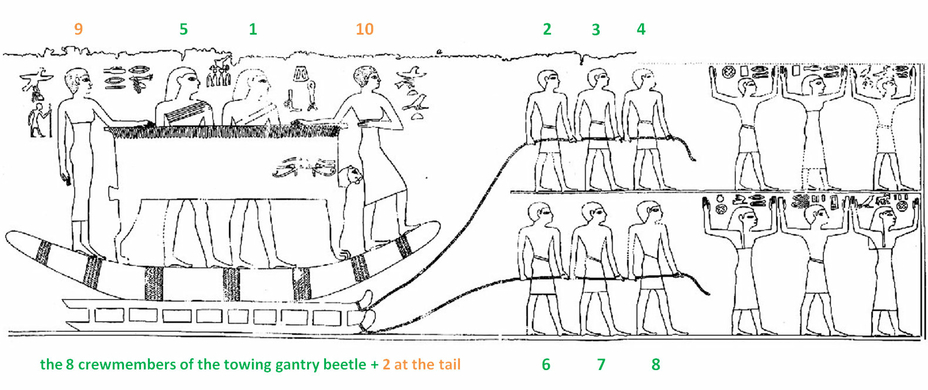
Theban hypogeum tomb of Senet and Antefoker TT60. Image dgd_XIX posted on osiris.net : https://www.osirisnet.net/popupImage.php?img=/tombes/nobles/antefoqer/photo/antefoqer_ndgd_XIX.gif&lang=en&sw=2560&sh=1440
12.01 The 8+2 crewmembers of the hauling beetle
I've been puzzled for some time about these black wooden sarcophagus of Yuya and Tjuyu (Tuya), because some of them were showing 4 characters on each side, while other ones were showing 5 characters. Also the sarcophagus of Yuya doesn't even have a bottom floor : the inner coffins are put directly onto the floor. How strange is that!
I was puzzled because I was only thinking about only one structure : the hauling beetle, and I didn't understand all these differences in their design.
And then I understood (or I think I did!), these 2 sarcophagus weren't representations of one structure only : one was a representation of the hauling beetle, but the other one represented the impactor.
The hauling beetle, if I'm correct, was operated by 10 people (5 on each ramp), but the impactor was only moved by 8 of them (4 on each ramp). The 2 extra crewmembers weren't inside the beetle because they had to operate the latch bolts and the ropes when the beetle was coming back up.
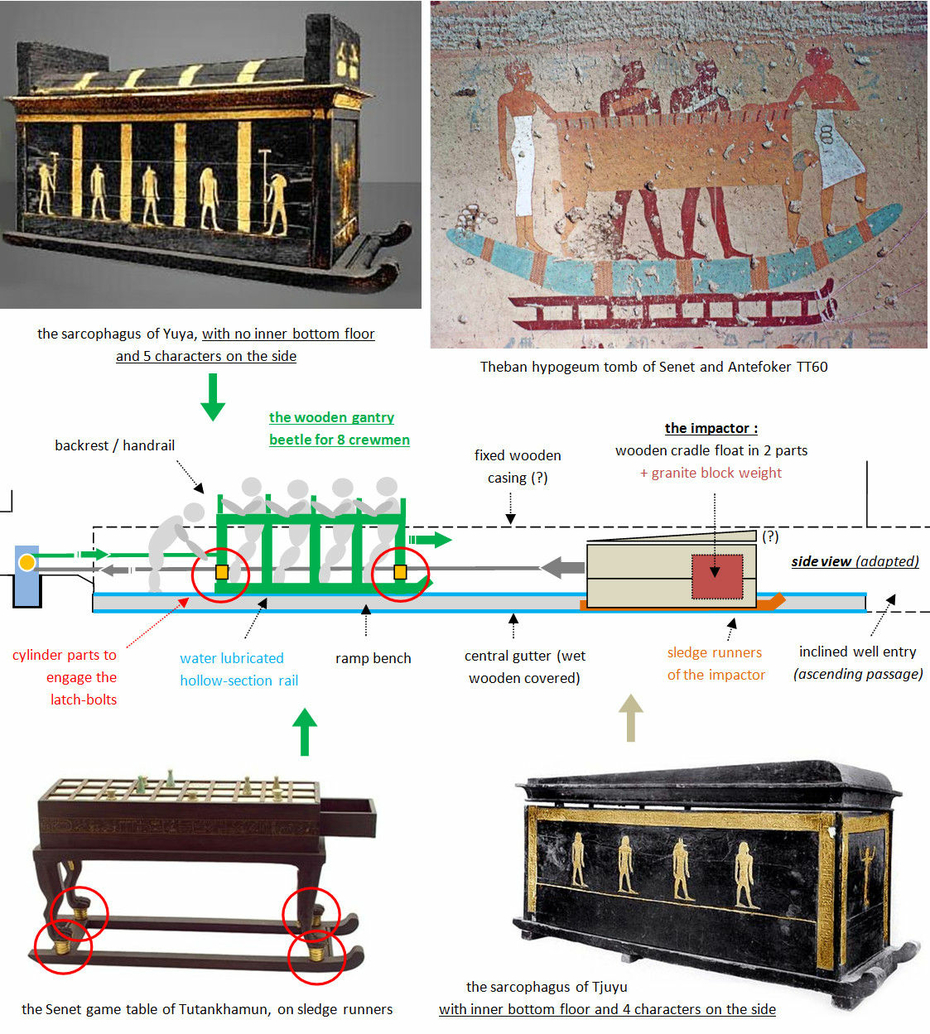
12.02 The golden cylinders between the sledge runners and the paws of the Senet game table's sledge
The presence of the golden cylinders on the Senet game table discovered in the tomb of Tutankhamun, looks weird, and it looks like they don't have any purpose that comes to mind, but if it is a faithful copy of the original beetle of the Great Pyramid, it makes perfectly sense.
In my theory, each time the beetle reaches another of the 25 steps of progression towards the bottom of the grand gallery, it pushes a pair of latch-bolts into its walls that automatically pop back up to secure each step.
The golden cylinder parts at the bottom of the animal paws of the game table, could have been the parts that were in contact with the latch-bolts.
The fact that these cylinders were golden painted could totally be a simple reference to their importance on the original beetle, but it could also point out that these parts were in metal, or metal covered, so that their action on the latch bolts would have been in the most efficient way possible.
12.03 The speed of the impactor
Also, we need to talk about the "spoiler like" design of the top part of the sarcophagus of Tjuyu. Until now, I didn't try to evaluate the maximum speed gained by the impactor in its descent towards the inclined well, but maybe we should, because maybe this "spoiler like" part is really a spoiler.
With absolutely no evidence at all, let's say with pure instinct, I'd say that the maximum speed of the impactor would have been maybe close to 60 or 65 km/h, but again, this is only guesswork (that would be around 40 miles per hour).
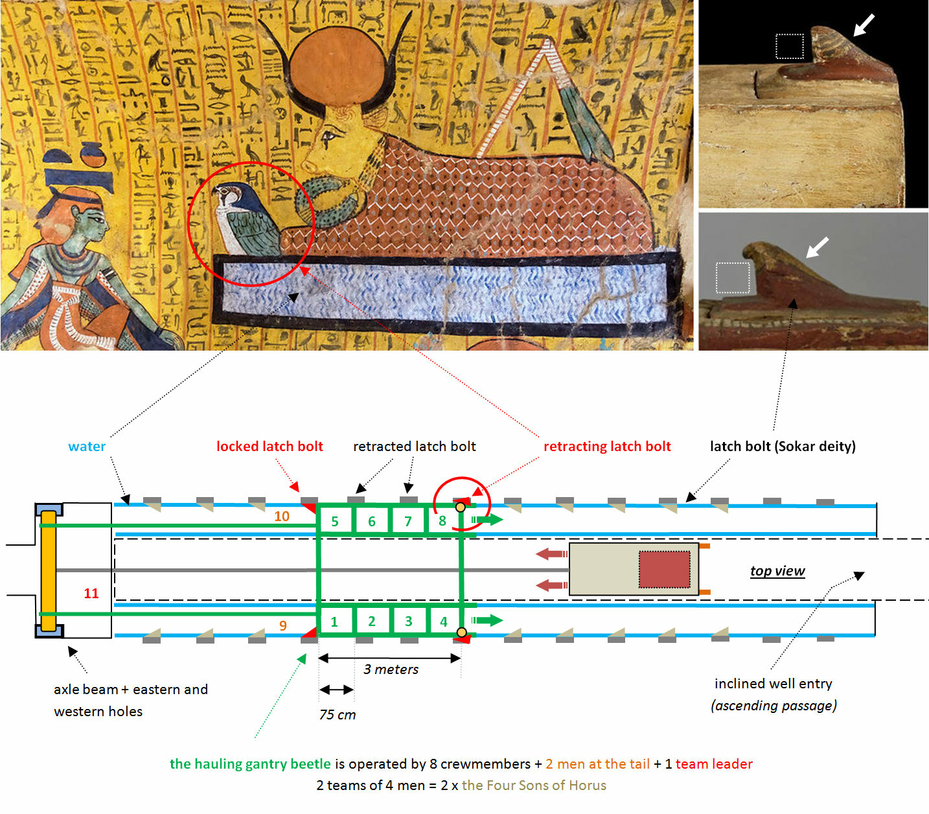
Hathor as a cow from the tomb of Irynefer TT 290 at Deir el-Medina, thanks to Kairoinfo4U : https://www.flickr.com/photos/manna4u/11433106165
Ptah-Sokar-Osiris figure from the Louvre in Paris (top right image), Numéro principal : N3512 : https://collections.louvre.fr/en/ark:/53355/cl010018325
12.04 The latch bolt representations in Sokar and his triangular shape
In the relief from the tomb of Irynefer TT 290 at Deir el-Medina, we can see that the squatting falcon god Sokar is a metaphoric representation of the latch bolts of the Grand Gallery : Hathor as a cow, looks like she is gonna run over the falcon, exactly like the towing beetle would do on the latch bolts.
You can see in this representation of Sokar as a falcon, that only his head is important : the falcon's head is immobilizing the cow.
But on the Sokar representations on the right, and in many other ones, you see that what is really important is the triangular shape of the falcon.
That triangular shape is directly referring to the latch bolts' own shape.
12.05 Hathor as a cow is a metaphoric representation of the hauling beetle
As a matter of fact, if the falcon Sokar represents the latch bolts on the above relief of Hathor as a cow, it means that Hathor, and most probably cows in general, are the metaphoric glorifying representations of the hauling beetle.
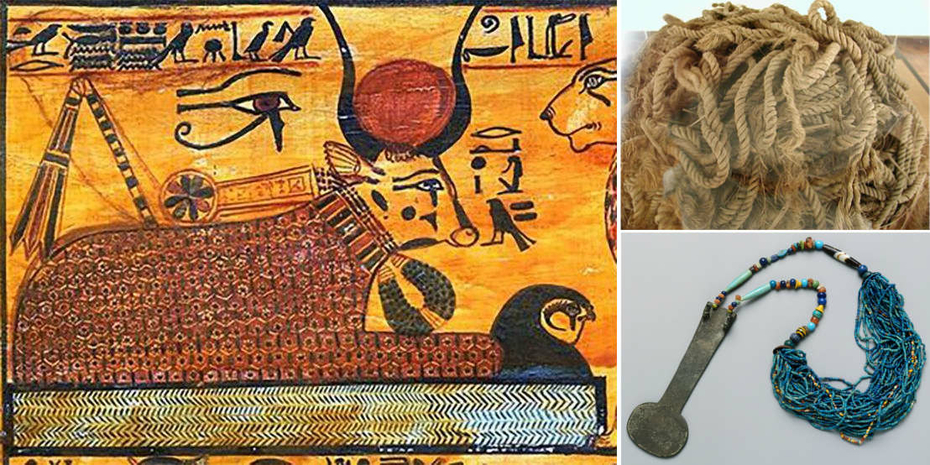
Left image of Mehet-Weret in its funerary appearance, Khonsu sarcophagus TT1, Cairo Museum. Original image from UCL University College London : https://www.ucl.ac.uk/archaeology/events/2021/nov/rethinking-visual-aesthetics-ancient-egyptian-writing
Original rope of the Solar Barque of the Great Pyramid of Giza : https://fr.wikipedia.org/wiki/Corde_(outil)#/media/Fichier:Cordes-originales-barque-kh%C3%A9ops.jpg
Menat necklace from Malqata at the Metropolitan Museum of Art, New-York (left and center) 1390–1353 B.C. New Kingdom, Dynasty 18. Reign of Amenhotep III, https://www.metmuseum.org/art/collection/search/544509
12.06 The representation of the original towing ropes
On the above images of cow deities, we can also decipher some other attributes that were associated to cows, and in particular, the towing ropes : the small beads of the Menat necklace are (most probably) a direct reference to the original natural ropes that connected the impactor to the hauling beetle.
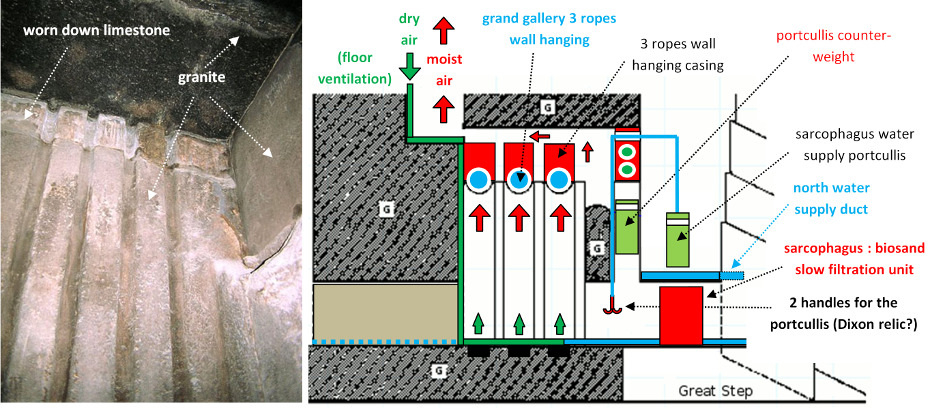
12.07 The Antechamber drying room for the 3 ropes of the Hauling Beetle
The problem with the 3 ropes of the Grand Gallery, is that they were made of natural fibers, most probably papyrus, and that they were used in permanent humid conditions : the gallery was completely surrounded by water sources (the King's chamber, the inclined well, the horizontal cooling passage and water was also running inside the central gutter itself).
Because a natural fiber rope will rot if stored in humid conditions, a special chamber had to be prepared for this role, and equipped with a very effective ventilation system to assure a perfectly efficient dry storage.
That special chamber was the antechamber.
If no portcullis have ever been found in this antechamber or anywhere else in the pyramid, it is because there never was any portcullis in the first place.
The antechamber never had any portcullis, it was the 3 ropes storage chamber, with 3 independent compartments. The ventilation of this chamber came from a little opening that was located on the top part of the south granite wall and that appears today filled with a limestone cement of very low quality.
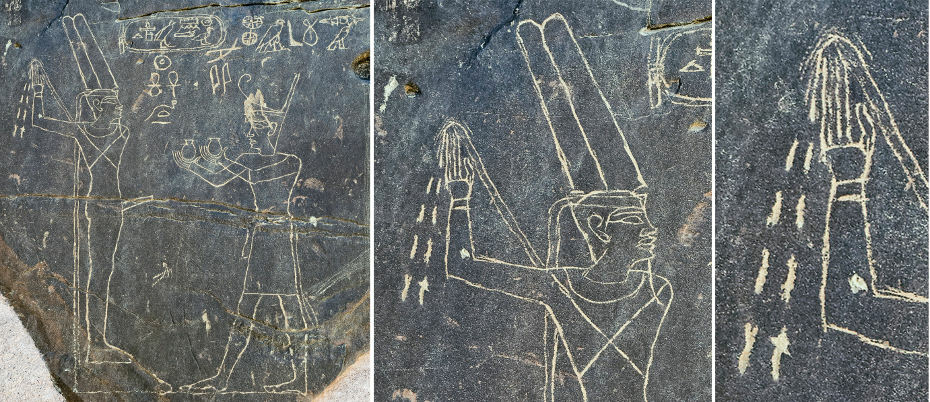
Wadi Hammamat: Dynasty 11, Nebhepetre Mentuhotep II. Photographed by Kairoinfo4U and posted on flickr : https://www.flickr.com/photos/manna4u/25932728632/in/photostream/
12.08 The flail is referring to water...
On the Wadi Hammamat's reliefs, we can clearly distinguish liquid getting out of some kind of pipe, but from that it is still very hard to imagine the exact meaning of what we call today a flail.
Fortunately, the following images of the Api Bull can make us understand its precise meaning.
12.09 Because the flail is referring to the impactor splashing water everywhere like cars do
This element will most probably cast some serious doubts among readers, because the flail was also about water.
In the drawing made by Champollion of the Apis bull below, it is really not difficult to imagine that water is passing through both the snake and the flail. Many people will (one day) agree on that.
There is no problem to understand that the snake is a representation of the pressurized water that was created in front of the impactor and resulting in its collision with the waters of the well (the primordial waters, Nun). The impact creates chaos and eject some water, under pressure (Atum) to the fog nozzle.
The flail is the one which is gonna cause disbelief, because I think that it is representing the water splashes that followed the impactor descent. The impactor sledge runners would have had to be constantly maintained wet, and if its speed was about between 60 and 65 km per hour (about) 40 miles per hour, water splashes would have been inevitable.
I'm conscious though, that this kind of affirmation about the water splashes will make a lot of people to laugh ; but I can't blame them, they've been fed for so long with so many cute stories, talking about good and evil, about family relationships between gods, about how important it was for ancient Egyptians to live in perfect balance in life, etc.
Ancient Egyptians were so much than that, and first of all, they were very facetious.
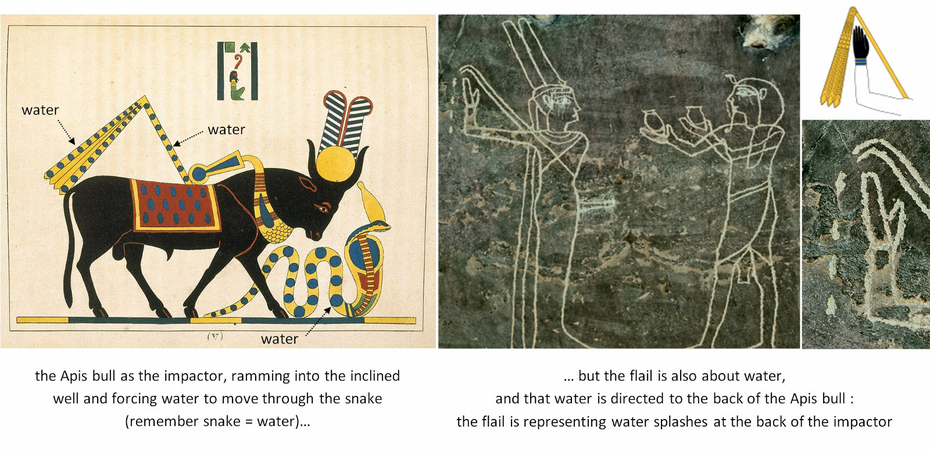
Api or Hapi (Apis, Taureau Consacré a la Lune)", 1823-25. Printed material. Brooklyn Museum : https://www.brooklynmuseum.org/opencollection/archives/image/55326
Wadi Hammamat stone reliefs representing the ancient Egyptian god Min and revealing the real nature of the flail (nekhakha), Dynasty 17. Photographed by Kairoinfo4U and posted on flickr : https://www.flickr.com/photos/manna4u/25999304796/in/photostream/
12.10 The Apis Bull is a representation of the impactor
The Apis Bull drawing made by J.F. Champollion is a gold mine, because from this drawing we can conclude that the Bull is a representation of the impactor.
Not only the splashing water cannot be atributed to anything else than the impactor running down the Grand Gallery at full speed (around 60 or 65 km/h, or 40 miles per hour, maybe), but the front part of the drawing is also exceptionnal, because it is showing the pressurization of the water by the impactor.
12.11 The Apis bull walking onto the snake... and the water passing through that snake
On the Apis Bull drawing made by J.F. Champollion, it looks like the feet of the Bull are put just next to the snake, but the real meaning is that they are put onto the snake.
It is here the same metaphor ancient Egyptians used about putting weight upon the Great Serpent Apep (whether it is the weight of a sycamore tree, of entire human bodies or just legs).
The Apis Bull is putting its weight upon the snake.
And as a result, water is passing through the snake : the blue dots onto the flail and onto the snake are a representation of the water passing through them.
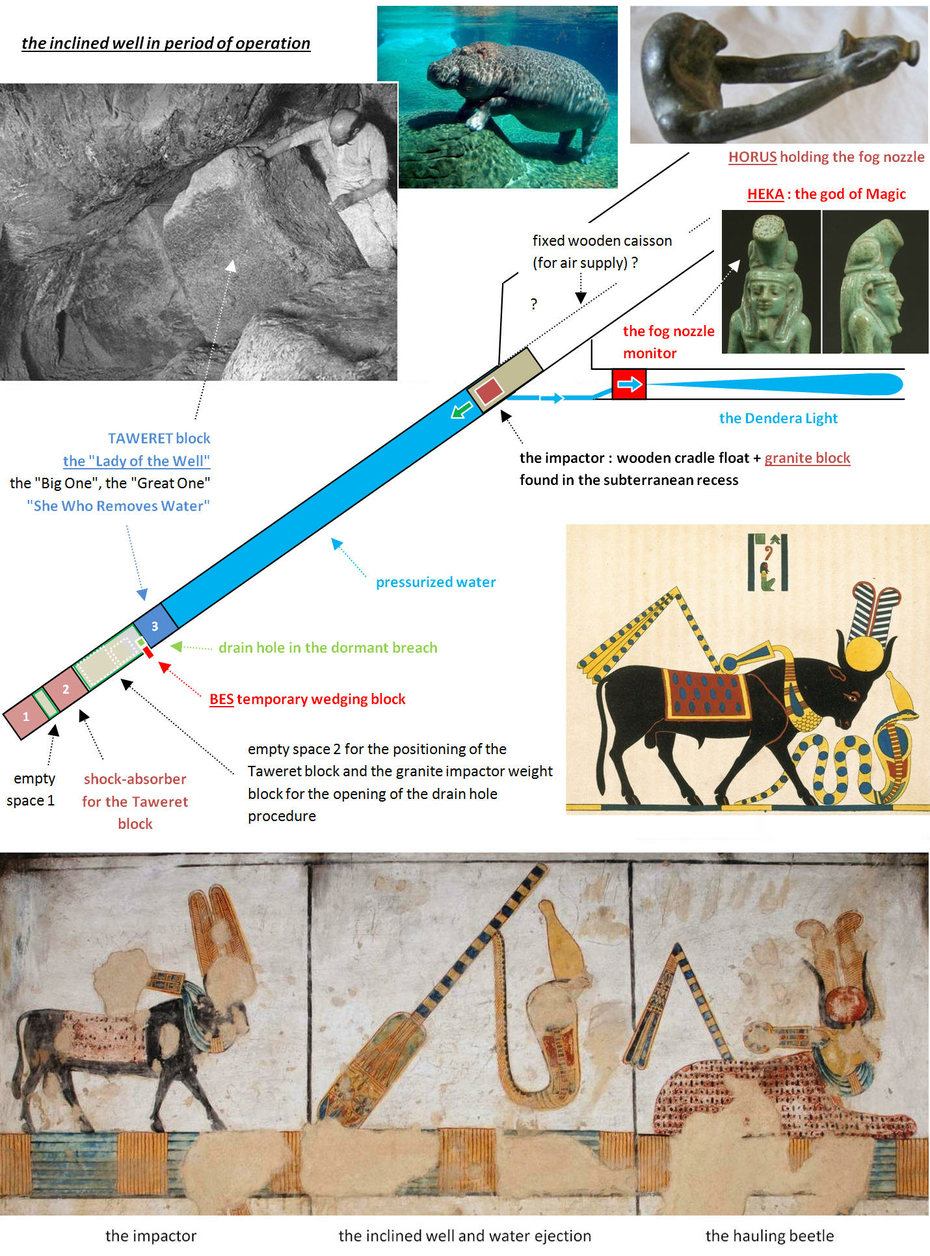
Top : Api or Hapi (Apis, Taureau Consacré a la Lune)", by J.F. Champollion 1823-25. Printed material. Brooklyn Museum : https://www.brooklynmuseum.org/opencollection/archives/image/55326
Bottom : KV 11: Ramesses III, side chamber, Image # 21077. Image from ARCE, American Research Center in Egypt in partnership with the American University in Cairo Egyptology Department : https://thebanmappingproject.com/index.php/images/21077jpg
12.12 The representation of the inclined well in Rameses III KV11
The above relief in the tomb of Ramesses III KV11, not only is depicting the equipment of the Grand Gallery, but it is also representing the inclined well itself.
On the right image, we've seen that it is water that is passing through the flail : they have represented this water flow with what could be interpreted as (huge) liquid droplets. And these exact same water droplets are also represented on the weird central drawing, showing an inclined element from which a snake is getting out.
Thanks to Champollion's drawing, we also know that these same exact water droplets were also passing through the snake. We already knew that snakes were water metaphors, but here we also know that the water was in movement.
In other words, on this relief of KV11, we have the entire operating system that was creating the pressurized water :
• the impactor : the Apis bull
• The hauling beetle progression powered by the latch bolts (plus the impactor water splashes) : the cow
• The inclined well and its small amount of ejected pressurized water : the snake.
And we also know, that this particular snake is Atum (details in previous post).
12.13 The 3 components needed to obtain pressurized water : the impactor / the inclined well / the hauling beetle
We've seen that Hathor as a cow is a representation of the hauling beetle, running over the latch bolts.
We've also seen that the Cow was a representation of the hauling beetle, and that the Bull was a representation of the impactor. So, it is pretty easy to understand the above set of images from Ramesses III KV 11 : they are showing the 3 elements that combined together were producing the pressurized water.
These elements are not set in a modern logical sequence, like we'd do today, and probably there is here another meaning in itself.
Or maybe, it is purely esthetic to put the representation of the inclined well in the middle…
About this particular central representation of the inclined well, you'll have notice that water (remember snake = water) is getting out of it : that is the small amount of pressurized water redirected towards the evaporative cooling passage.
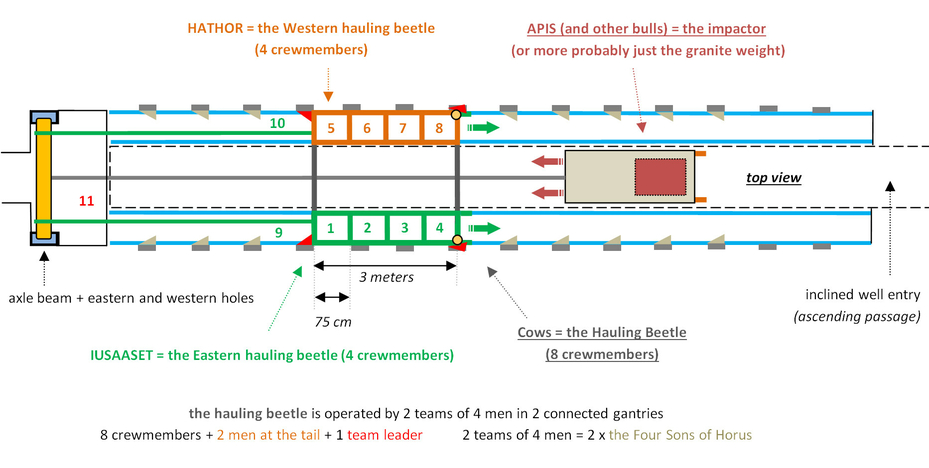
12.14 The 2 Hauling Beetle units of 4 crewmembers were Hathor and Iusaaset
"In ancient Egyptian religion, Apis or Hapis, alternatively spelled Hapi-ankh, was a sacred bull worshiped in the Memphis region." Source
"As reported by Plutarch, the Mnevis bull was second only to the Memphite Apis bull in importance. Similarly to the Apis bull, the Mnevis bull's movements were thought to be driven by divine will, and used as an oracle. The priesthood of Mnevis also went as far as to claim that Mnevis was none other than the father of the more famous Apis."
"The Mnevis bull was entitled to two concubines, more precisely two cows representing Hathor and Iusaaset…" https://en.wikipedia.org/wiki/Mnevis
These excerpts could validate the previous assumptions :
• For example it is said that "Similarly to the Apis bull, the Mnevis bull's movements were thought to be driven by divine will."
"Divine will" could mean "by itself" or more literally "by the force of god(s)", and that is precisely what would have look like the impactor which was descending the slope of the Grand Gallery by itself, and getting back up to the top of the Gallery by the force of the 8 hauling beetle crewmembers : 2 times the Four Sons of Horus gods.
• Also, like I've suggested in the above top-view drawing of the Grand Gallery, the impactor was powered by a hauling beetle that was actually made of two connected gantries, one on the East ramp and the other one on the West ramp. And that is precisely what is describing the following excerpt : "The Mnevis bull was entitled to two concubines, more precisely two cows representing Hathor and Iusaaset…".
It would mean that the cow Hathor was one of these gantries, and Iusaaset the other one.
On the above drawing, I've set Hathor on the West ramp and Iusaaset on the East ramp, but this is purely arbitrarily.
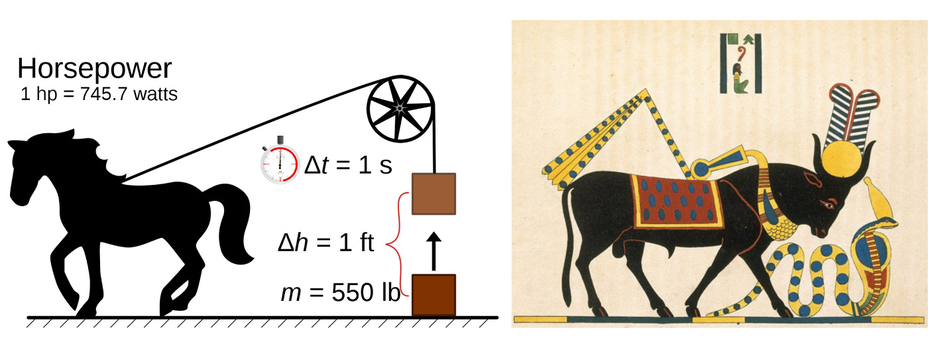
Horsepower draw : https://en.wikipedia.org/wiki/Horsepower#/media/File:Imperial_Horsepower.svg
12.15 The horsepower metaphor versus the bullpower metaphor
It is funny to draw a parallel between modern engines and the hauling beetle of ancient Egyptians : while we are today measuring the power of our motors in horsepower, because we chose to use the horse draft metaphor, they used the bull metaphor to represent the strength and the power of the impactor.
Of course, for ancient Egyptians, it just didn't make any sense to make a difference between the hauling beetle and the impactor, in term of power. It was the same thing. The beetle just transmitted its power to the impactor, hence the metaphoric representation of the impactor into a bull.
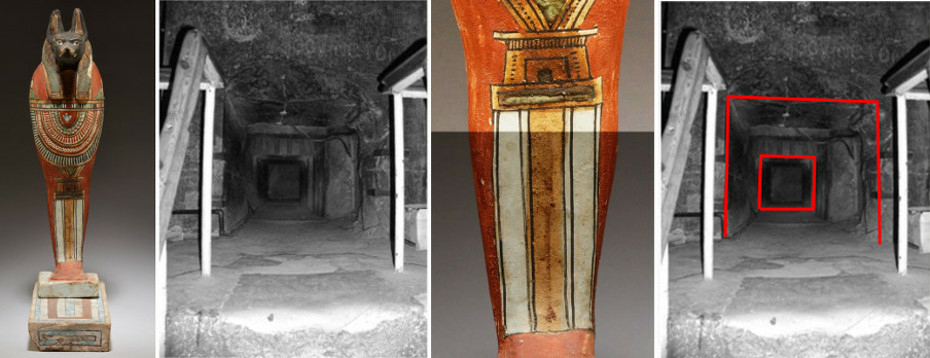
Image on the left and center : Funerary Figure of Duamutef. 400–30 B.C. Late Period–Ptolemaic Period. The Metropolitan Museum of Art, New-York. On view at The Met Fifth Avenue in Gallery 133.
12.16 The Grand Gallery layout replica into the Four Sons of Horus figures from the MET
The fact that the Hauling Beetle units were operated by 4 crewmembers, is also reinforced by the importance that took the Four Sons of Horus representations in ancient Egypt, and the fact that one particular set of these Four Sons of Horus figures, now in the Metropolitan Museum in New-York, is very clearly reproducing the exact layout of the Grand Gallery of the Great Pyramid of Giza.
The first above photograph of the Four Sons of Horus figures, visible at the Metropolitan Museum of Art is showing a jackal-headed figure representing Duamutef, the god who protected the stomach of the mummies.
The half lower part of this image has been magnified and partially enlightened on the second picture of the figurine so that we can see clearly the different structures depicted.
And my assumption is that what we have here is a complete representation of the grand gallery layout of the Great Pyramid of Khufu :
1/ The eastern and western ramps, with 2 hollow section rails by ramp
2/ The central gutter (painted here in yellow, but in blue in the Catawiki figure, above)
3/ The top platform, with what could be the axle beam for operating the 3 ropes
4/ The south wall of the grand gallery
5/ The opening of the antechamber (red line)
6/ The opening of the passage to the King's chamber (red square)

Funerary Figures of the Four Sons of Horus, with Imsety (human head) second from the left. 400–30 B.C. Late Period–Ptolemaic Period. The Metropolitan Museum of Art, New-York. Imsety is the only one with a human head, the three other Sons of Horus figures have heads representing a jackal (god Duamutef), a baboon (god Hapy) and a falcon (god Qebehsenuef).
12.17 The axle beam for operating the 3 ropes of the gallery, was inserted into the 2 holes of the platform
The second magnified image is from the figurine of Imsety, the god that protected the liver, and who was one of the Four Sons of Horus. This image shows the eastern and western holes of the platform and it also depicts that the axle beam ends were having tenons that would fit inside these holes.
If this draw of the platform is to be taken literally, that means that the main axle beam was placed onto that platform.
12.18 The Four Sons of Horus real meaning : the scarab team
Inside the grand gallery of the Great Pyramid, it was not 1, but 2 beetle scarabs that were operated. The question of knowing if they would be physically connected or not, is not so easy to answer, but I think they were.
Anyway, many or most of representations of scarab amulets, are showing 4 or 8 elements, and I think that the Four Sons of Horus are representing the team of the scarab beetle unit. That is the reason why the complete layout of the grand gallery is depicted on these Four Sons of Horus figures visible at the Metropolitan Museum.
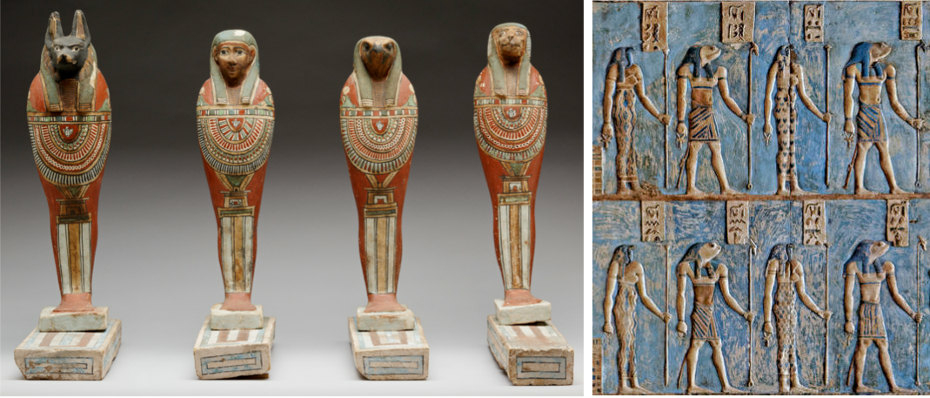
The Four Sons of Horus at the Metropolitan Museum of Art, New-York : https://www.metmuseum.org/art/collection/search/564551
A depiction of the Ogdoad from a Roman era relief at the Hathor temple in Dendera in which some have frog heads and others have serpent heads : https://en.wikipedia.org/wiki/Ogdoad_(Egyptian)#/media/File:L'Ogdoade_d'Hermopolis.jpg
12.19 The glorifying representation of the 8 crewmembers of the hauling beetle : the Ogdoad
"The Ogdoad in Egyptian mythology, (Ancient Greek: ὀγδοάς "the Eightfold"; Ancient Egyptian: ḫmnyw, a plural nisba of ḫmnw "eight") were eight primordial deities worshiped in Hermopolis."
Also : "References to the Ogdoad date to the Old Kingdom of Egypt, and even at the time of composition of the Pyramid Texts toward the end of the Old Kingdom, they appear to have been antiquated and mostly forgotten by everyone except their theologians." https://en.wikipedia.org/wiki/Ogdoad_(Egyptian)
Of course, the fact that the Ogdoad seem to have been "antiquated" and "mostly forgotten", while the Four Sons of Horus representations were so highly worshiped, could indicate that the Hauling Beetle units seem to have been way more important than the combination of the 2 units, and its 8 crewmembers.
Could it means that the units were not connected after all ?
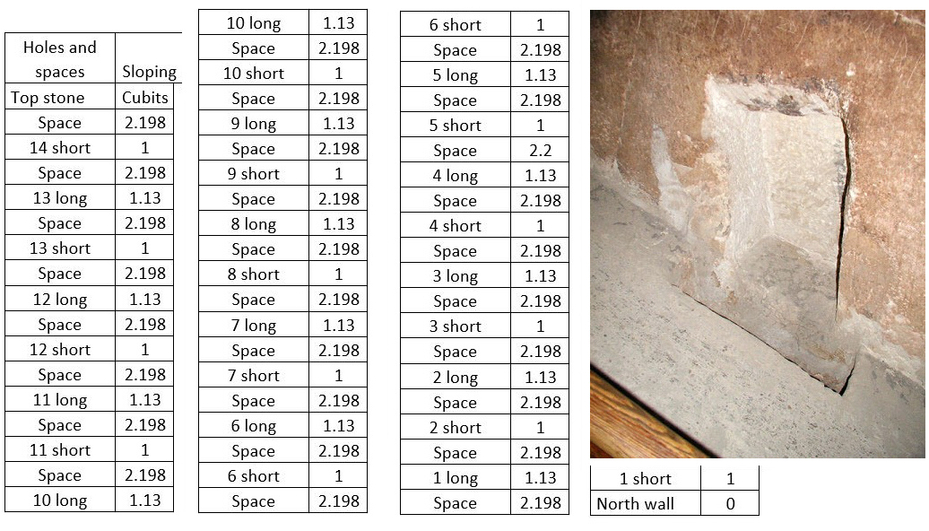
12.20 The wooden hollow-section rails of the grand gallery
When we look at the numbers indicating the position of the holes on the ramps of the Grand Gallery, there is one that comes many times, and that is 2.198 cubits.
I tried to come up with an interpretation of this very particular number, repeating itself over and over again, and I had the idea of using pieces of wood that would all have the exact same dimensions. It may be a good idea or not, but I like this idea : it is easy to make and you don't have to bother where to put each element, they are all the same.
The funny thing is that to obtain this 2.198 cubits over and over, with the other numbers changing, you end up with elements of 3.198 cubits.
These rails were all the same, with a 3.198 cubits length. Because the ramps would have been covered with wood, like they are (or were) equipped for the tourists to walk on, and because there had to be hollow section rails for the Hauling Beetle to move without friction, I called these standards elements "rails" but they were most probably wood planks with hollow section rails built in..
The hollow-section rails had certainly received an additional treatment to reduce even more the friction. What really makes wood extremely slippery outdoors, isn't just the fact that the wood is wet, but the presence of a bio-film at its surface. This bio-film is made of cyanobacteria colonies living on its surface and I have no doubt that this kind of bio-film was mandatory for the rails.
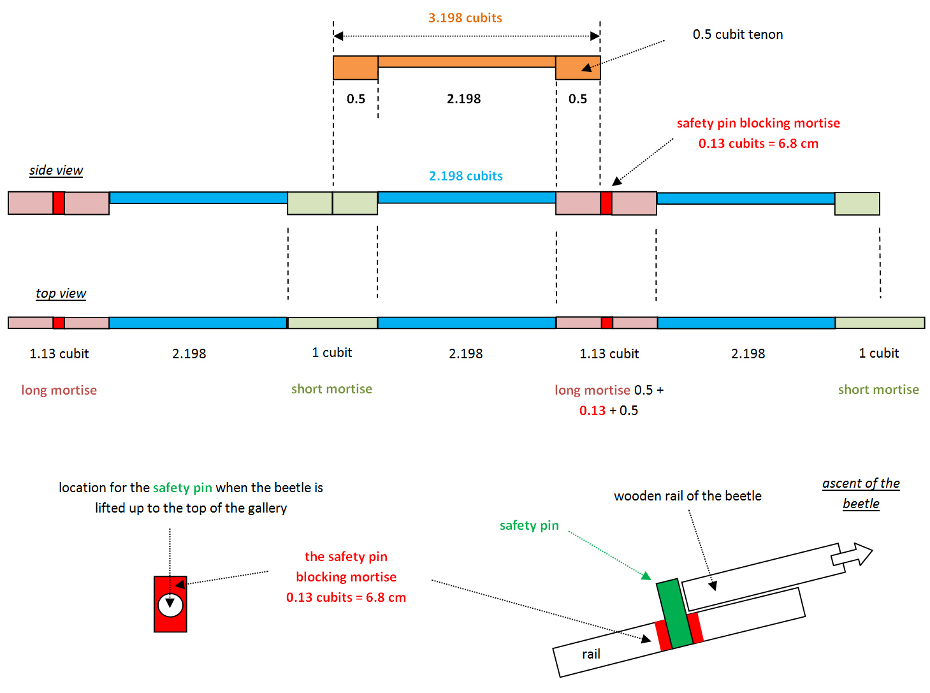
12.21 The beetle operating procedure in the grand gallery
1 • The beetle is on top of the grand gallery. The 2 ropes it is attached to are 100% rolled up around the winding beam and the impactor is simply floating inside the well, its rope 100% unrolled and resting on the wooden floor of the platform at the top of the gallery.
2 • We need to get the impactor back, so the first thing to do, is to drop its unrolled rope, inside the fixed casing. Now, we can reattach the end of the rope to the impactor.
3 • The 10 crewmembers can then start to move the beetle down the gallery. The descent of the beetle allowed to raise the impactor up to the top of the grand gallery, in 25 very demanding steps.
They were going backwards, because this is in that position that you can deliver maximum pulling force, using your legs and your back. Every step was secured by 2 latch bolts, one on each ramp, that were inserted inside the wall niches (2 x 25 niches, 50 niches total).
The latch bolt is what you have on every single door you have at home. With this latch bolt, you can slam the door closed just by pushing it, and it won't move again, unless you move the handle down. The 2 crewmembers at the top of the beetle were certainly the most experienced and were working with their eyes permanently turned to the latches, checking that it would correctly pop-up again once it had been pushed inside the wall by the passage of the beetle's slider.
The role of the 2 crewmembers who were not inside the Hauling Beetle units was mainly to operate the latch bolts : they were our modern handles and they forced the latch bolts into their niches so that the Beetle could get back to the top of the gallery and then they released them after its passage for its next descent.
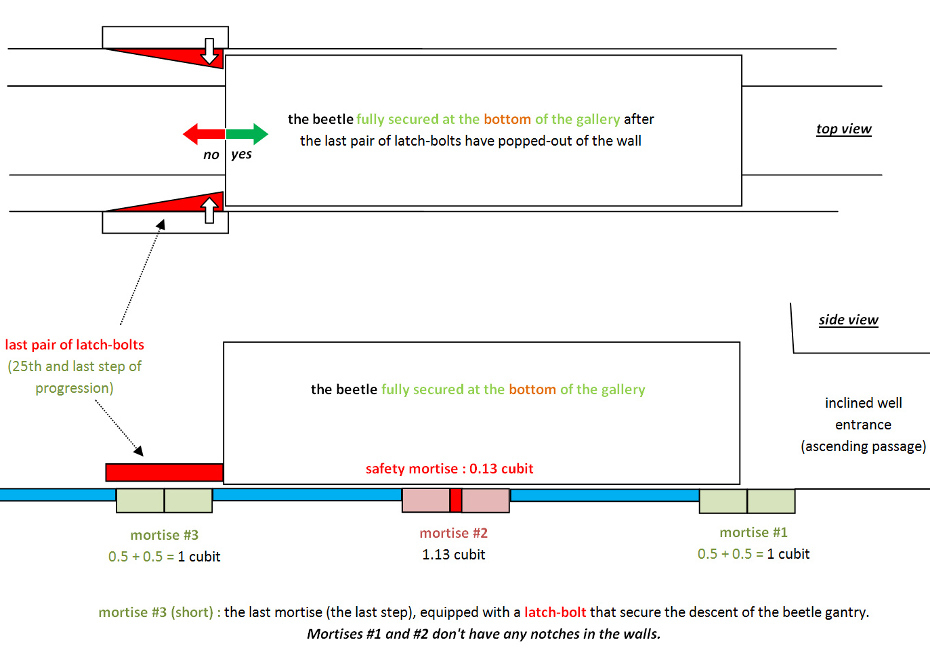
4 • As the Hauling Beetle is moving down the gallery, its 2 ropes unwind from the beam and the impactor's rope winds up at the same time.
5 • The Beetle is now secured at the bottom of the gallery by the last latch-bolt. Its ropes 100% unrolled on the ramp. The impactor is secured at the top of the gallery, its rope is 100% rolled up on the beam.
6 • At the bottom of the gallery, a blocking slab shim is inserted between the beetle and the wall and it can now be released from the last latch bolt.
7 • Before the release of the impactor, the Beetle first needs to be pushed up back at the top of the gallery by 4 men, using the transversal beams of the beetle (2 on each side). 2 other men stay behind the beetle and secure the climbing with the safety pins they insert inside de safety mortises. 2 other men pull the ropes of the ramps from the top platform (1 on each side) and these 2 ropes then wind up automatically when the last 2 men of the crew unroll the impactor rope on the wooden floor of the platform. The climbing of the Beetle though, wasn't very challenging (there was nothing else to lift than the gantry itself), so the safety precautions were limited to one out of two steps. And this is why we have the long mortises : every two steps, a safety pin of 6.8 centimeters had to be inserted in it.
8 • Both the Hauling Beetle and the impactor are now secured on top of the grand gallery. The Beetle ropes are rolled around the axle beam. The impactor rope is neatly resting on the wooden floor.
9 • Everything is ready for the next cycle, the impactor can now be unhooked from its rope and ready to be released.
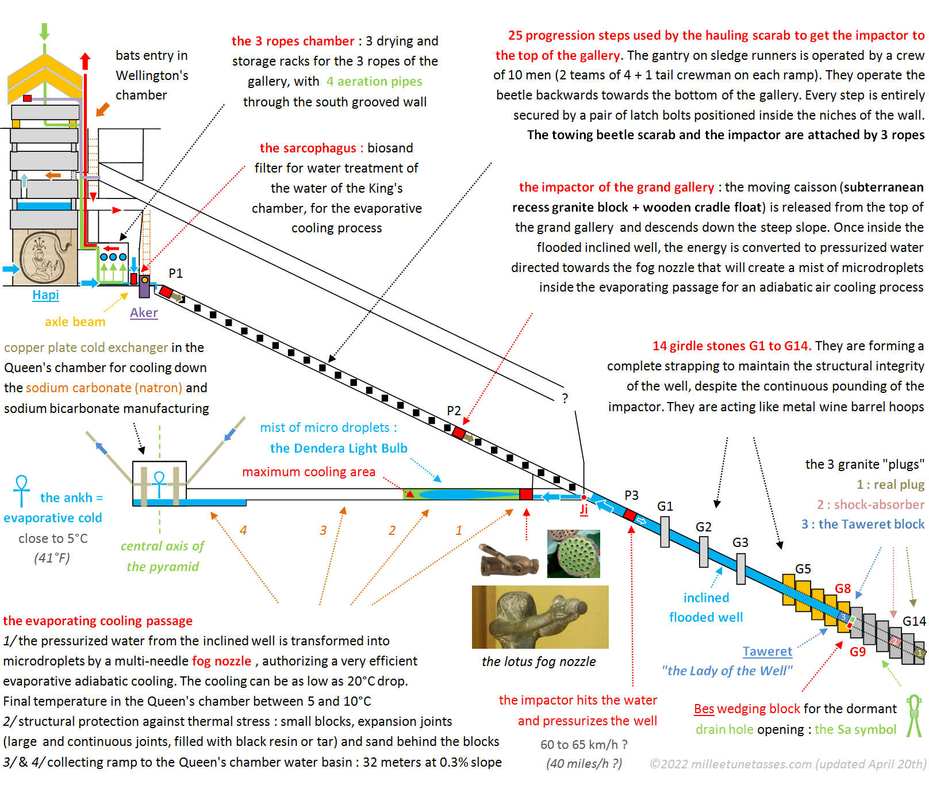
Diagram of the Great Pyramid of Giza in operation, before the shutdown procedure and the draining of the inclined well.
12.22 Summary of the study : hidden behind the academic vision of the ancient Egyptian religion, a vast number of metaphors are describing some of the most advanced science and technological knowledge of that time : ancient Egyptian gods were nothing else than pharaohs' metaphoric self-glorifications of their theoretical and experimental scientific accomplishments in physics and chemistry.
Pharaohs used the power of Science to legitimate themselves as kings of Egypt : they forged an entire religion, based on science to rule their kingdom, and they presented that science as Magic.
The end game of this technological program that probably started on the very first Dynasty, was the Great Pyramid of Giza where evaporative cooling was engineered in the known part of the pyramid from the pressurized water produced in the inclined well, known today as the ascending passage.
The evaporative cold simply took advantage of the power of water, and was most probably necessary to cool down chemical manufacturing of sodium carbonate and sodium bicarbonate produced by an ammonia-soda Solvay process, as suggested by the very strong ammonia smell and the limestone kiln in the so-called burial chamber of the Red Pyramid. At that time, sodium carbonate was called natron, and it was the salt used for the mummification of the pharaohs (Sections 14, 15 and 16).
The cooling seems to have represented the most difficult part of the process, as suggested by the Step Pyramid's official name : according to scholars, the very first pyramid complex, the Step Pyramid of Djoser, was called "the refreshment of the Gods". No doubt that a more accurate translation would certainly be "the cooling of the Gods".
It means that ancient Egyptians were the first civilization to master a Solvay-like process for sodium carbonate manufacturing, long before it got reinvented in the 1800's in Europe. The key elements of that process is the temperature control of the chemical reactions (the cooling), and the dome shaped plate necessary for the counterflow chemical reactions to occur in an efficient way. That counterflow reaction plate is what really is the disc of Sabu.
As shown with Akhenaten and Nefertiti, the creation of the evaporative cold was the most sacred accomplishment of all (Section 17), and this is exactly what the Dendera Light is all about : the Dendera Light is the fog of microdroplets of liquid water that evaporates and creates the cold. Talking about the snake inside the Dendera Light Bulb : "The field surrounding Ra’s snake form is referred to in ancient Egyptian literature as protective magical energy in liquid form that all gods and pharaohs possess" (Faulkner, Section 2).
Everything that had been done in the Great Pyramid of Giza inspired most of the ancient Egyptian religion, and it had been glorified into what we know today as the Underworld.
The Underworld is referring to the chambers and passages of the Great Pyramid of Khufu, and in particular to the Grand Gallery where a hauling gantry beetle operated a wooden coffin shaped impactor that had a small nested granite block inside it. The impactor generated endlessly, over and over, maybe every 15 minutes the pressurized water that was then transformed into a fog of microdroplets inside the horizontal cooling passage.
The Grand Gallery of the Great Pyramid where the act of hauling was done, is the "Secret Hauling Cavern of the Underworld" described in the Amduat "Book of the Hidden Chamber".
The most important chamber of the Great Pyramid wasn't the King's chamber that only was the main water tank of the pyramid, but the Queen's chamber, the only one on the central axis of the pyramid. Because the Queen's chamber was inaccessible from the rest of the pyramid, it was glorified into the "Hidden Chamber of the Underworld" (Section 11), and because the Queen's chamber was the coolest place in the pyramid (about 5°C / 41°F), and with a constant 100% Humidity rate, this chamber was the one where the biggest amount of very hard salt encrustation had been documented by the first explorers of the pyramid in the 1800's and before it had been removed in 1998 by Zahi Hawass (Section 1). Very hard salt encrustation is the signature of the evaporative cooling process, even nowadays.
The most incredible thing is that pretty much everything I've just said, actually appears in one single myth, but it doesn't originate from ancient Egypt : it is the "Churning of the Ocean" Hindu myth that produces the immortal nectar Amrita. The fact is that the endless churning of water that ends up with the production of an elixir that gives eternal life, is exactly what were doing ancient Egyptians in the inclined well : natron was the salt used for the mummification of pharaohs.
Natron gave eternal life to pharaohs, just like the Amrita (Section 19).
Poster un commentaire


